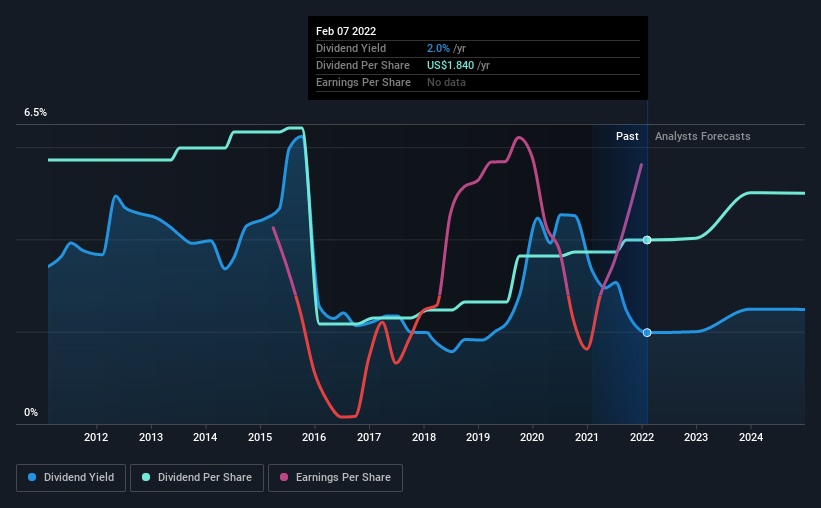ConocoPhillips (NYSE:COP) is about to trade ex-dividend in the next two days. Typically, the ex-dividend date is one business day before the record date which is the date on which a company determines the shareholders eligible to receive a dividend. It is important to be aware of the ex-dividend date because any trade on the stock needs to have been settled on or before the record date. Therefore, if you purchase ConocoPhillips' shares on or after the 11th of February, you won't be eligible to receive the dividend, when it is paid on the 1st of March.
The company's next dividend payment will be US$0.46 per share, on the back of last year when the company paid a total of US$1.84 to shareholders. Looking at the last 12 months of distributions, ConocoPhillips has a trailing yield of approximately 2.0% on its current stock price of $92.94. We love seeing companies pay a dividend, but it's also important to be sure that laying the golden eggs isn't going to kill our golden goose! So we need to investigate whether ConocoPhillips can afford its dividend, and if the dividend could grow.
Dividends are typically paid from company earnings. If a company pays more in dividends than it earned in profit, then the dividend could be unsustainable. Fortunately ConocoPhillips's payout ratio is modest, at just 29% of profit. Yet cash flows are even more important than profits for assessing a dividend, so we need to see if the company generated enough cash to pay its distribution. What's good is that dividends were well covered by free cash flow, with the company paying out 20% of its cash flow last year.
It's positive to see that ConocoPhillips's dividend is covered by both profits and cash flow, since this is generally a sign that the dividend is sustainable, and a lower payout ratio usually suggests a greater margin of safety before the dividend gets cut.
Click here to see the company's payout ratio, plus analyst estimates of its future dividends.

Have Earnings And Dividends Been Growing?
Stocks in companies that generate sustainable earnings growth often make the best dividend prospects, as it is easier to lift the dividend when earnings are rising. Investors love dividends, so if earnings fall and the dividend is reduced, expect a stock to be sold off heavily at the same time. That's why it's comforting to see ConocoPhillips's earnings have been skyrocketing, up 25% per annum for the past five years. Earnings per share have been growing very quickly, and the company is paying out a relatively low percentage of its profit and cash flow. This is a very favourable combination that can often lead to the dividend multiplying over the long term, if earnings grow and the company pays out a higher percentage of its earnings.
Many investors will assess a company's dividend performance by evaluating how much the dividend payments have changed over time. ConocoPhillips's dividend payments per share have declined at 3.5% per year on average over the past 10 years, which is uninspiring. ConocoPhillips is a rare case where dividends have been decreasing at the same time as earnings per share have been improving. It's unusual to see, and could point to unstable conditions in the core business, or more rarely an intensified focus on reinvesting profits.
To Sum It Up
Has ConocoPhillips got what it takes to maintain its dividend payments? It's great that ConocoPhillips is growing earnings per share while simultaneously paying out a low percentage of both its earnings and cash flow. It's disappointing to see the dividend has been cut at least once in the past, but as things stand now, the low payout ratio suggests a conservative approach to dividends, which we like. ConocoPhillips looks solid on this analysis overall, and we'd definitely consider investigating it more closely.
While it's tempting to invest in ConocoPhillips for the dividends alone, you should always be mindful of the risks involved. For example, we've found 4 warning signs for ConocoPhillips (1 makes us a bit uncomfortable!) that deserve your attention before investing in the shares.
If you're in the market for dividend stocks, we recommend checking our list of top dividend stocks with a greater than 2% yield and an upcoming dividend.
Have feedback on this article? Concerned about the content? Get in touch with us directly. Alternatively, email editorial-team (at) simplywallst.com.
This article by Simply Wall St is general in nature. We provide commentary based on historical data and analyst forecasts only using an unbiased methodology and our articles are not intended to be financial advice. It does not constitute a recommendation to buy or sell any stock, and does not take account of your objectives, or your financial situation. We aim to bring you long-term focused analysis driven by fundamental data. Note that our analysis may not factor in the latest price-sensitive company announcements or qualitative material. Simply Wall St has no position in any stocks mentioned.
The views and opinions expressed herein are the views and opinions of the author and do not necessarily reflect those of Nasdaq, Inc.


